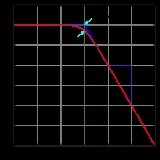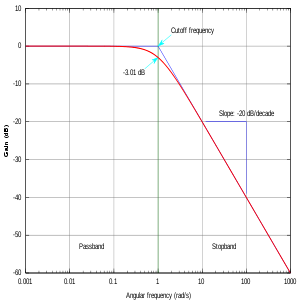
Voltage-controlled filter
Encyclopedia
A voltage
-controlled filter (VCF) is a filter
whose operating characteristics (primarily cutoff frequency) can be controlled by means of a control voltage applied to one or more inputs. Although popularly known for their use in analog music synthesizers, in general, they do have other applications in military and industrial electronics.
 A VCF allows its cutoff frequency
A VCF allows its cutoff frequency
and Q factor
to be continuously varied; it usually gives a lowpass response, but may also be switchable to allow highpass, bandpass or even notch responses. The filter may offer a switchable slope which determines how intensely signals outside the pass band become attenuated, usually 12dB/octave (a '2 pole' filter) or 24dB/octave (a '4 pole' filter).
In analog music synthesizers, filters typically receive audio from the oscillator(s). The oscillator generates an audio waveform, which (except for noise waveforms) includes a fundamental pitch and a series of harmonic partials. By varying the cutoff frequency
(the maximum frequency passed by the filter), the synth. operator can add or remove some of the partials to create more interesting and textured sounds.
In much electronic music, "filter sweeps" have become a common effect. These sweeps are created by varying the cutoff frequency of the VCF (sometimes very slowly) to reveal or conceal some of the oscillator's partials. Controlling the cutoff by means of an envelope generator, especially with relatively fast attack settings, simulates the attack transients of natural or acoustic instruments.
From the very beginnings of modular analog synthesizers, VCFs often include variable feedback which creates a response peak at a frequency just below the cutoff slope. This peak can be quite prominent, and when the filter's frequency is swept by an envelope generator, it creates "chirps" that are very popular and a trademark of traditional analog synth. sounds. Some synthesizers permit enough feedback to let the filter oscillate, and it can serve as a sine-wave source, although not necessarily with accurate pitch.
ARP Instruments
made a multifunction voltage-controlled filter module capable of stable operation at a Q greater than 100; it could be shock-excited to ring like a vibraphone bar. Q was voltage-controllable, in part by a panel-mounted control. Its internal circuit was the classic analog computer state variable "loop", which provided outputs in quadrature (although they did not emphasize that).
A VCF is an example of an active
non-linear filter
: however, if its control voltage is kept constant, it will behave as a linear filter
.
Voltage
Voltage, otherwise known as electrical potential difference or electric tension is the difference in electric potential between two points — or the difference in electric potential energy per unit charge between two points...
-controlled filter (VCF) is a filter
Filter (signal processing)
In signal processing, a filter is a device or process that removes from a signal some unwanted component or feature. Filtering is a class of signal processing, the defining feature of filters being the complete or partial suppression of some aspect of the signal...
whose operating characteristics (primarily cutoff frequency) can be controlled by means of a control voltage applied to one or more inputs. Although popularly known for their use in analog music synthesizers, in general, they do have other applications in military and industrial electronics.

Cutoff frequency
In physics and electrical engineering, a cutoff frequency, corner frequency, or break frequency is a boundary in a system's frequency response at which energy flowing through the system begins to be reduced rather than passing through.Typically in electronic systems such as filters and...
and Q factor
Q factor
In physics and engineering the quality factor or Q factor is a dimensionless parameter that describes how under-damped an oscillator or resonator is, or equivalently, characterizes a resonator's bandwidth relative to its center frequency....
to be continuously varied; it usually gives a lowpass response, but may also be switchable to allow highpass, bandpass or even notch responses. The filter may offer a switchable slope which determines how intensely signals outside the pass band become attenuated, usually 12dB/octave (a '2 pole' filter) or 24dB/octave (a '4 pole' filter).
In analog music synthesizers, filters typically receive audio from the oscillator(s). The oscillator generates an audio waveform, which (except for noise waveforms) includes a fundamental pitch and a series of harmonic partials. By varying the cutoff frequency
Cutoff frequency
In physics and electrical engineering, a cutoff frequency, corner frequency, or break frequency is a boundary in a system's frequency response at which energy flowing through the system begins to be reduced rather than passing through.Typically in electronic systems such as filters and...
(the maximum frequency passed by the filter), the synth. operator can add or remove some of the partials to create more interesting and textured sounds.
In much electronic music, "filter sweeps" have become a common effect. These sweeps are created by varying the cutoff frequency of the VCF (sometimes very slowly) to reveal or conceal some of the oscillator's partials. Controlling the cutoff by means of an envelope generator, especially with relatively fast attack settings, simulates the attack transients of natural or acoustic instruments.
From the very beginnings of modular analog synthesizers, VCFs often include variable feedback which creates a response peak at a frequency just below the cutoff slope. This peak can be quite prominent, and when the filter's frequency is swept by an envelope generator, it creates "chirps" that are very popular and a trademark of traditional analog synth. sounds. Some synthesizers permit enough feedback to let the filter oscillate, and it can serve as a sine-wave source, although not necessarily with accurate pitch.
ARP Instruments
ARP Instruments, Inc.
ARP Instruments, Inc. was an American manufacturer of electronic musical instruments, founded by Alan Robert Pearlman in 1969. Best known for its line of synthesizers that emerged in the early 1970s, ARP closed its doors in 1981 due to financial difficulties...
made a multifunction voltage-controlled filter module capable of stable operation at a Q greater than 100; it could be shock-excited to ring like a vibraphone bar. Q was voltage-controllable, in part by a panel-mounted control. Its internal circuit was the classic analog computer state variable "loop", which provided outputs in quadrature (although they did not emphasize that).
A VCF is an example of an active
Active filter
An active filter is a type of analog electronic filter that uses an amplifier stage. Amplifiers included in a filter design can be used to improve the performance, stability and predictability of a filter. An amplifier prevents the impedance of source or load stages from affecting the...
non-linear filter
Non-linear filter
A nonlinear filter is a signal-processing device whose output is not a linear function of its input. Terminology concerning the filtering problem may refer to the time domain showing of the signal or to the frequency domain representation of the signal. When referring to filters with adjectives...
: however, if its control voltage is kept constant, it will behave as a linear filter
Linear filter
Linear filters in the time domain process time-varying input signals to produce output signals, subject to the constraint of linearity.This results from systems composed solely of components classified as having a linear response....
.
See also
- Electronic filterElectronic filterElectronic filters are electronic circuits which perform signal processing functions, specifically to remove unwanted frequency components from the signal, to enhance wanted ones, or both...
- Non-linear filterNon-linear filterA nonlinear filter is a signal-processing device whose output is not a linear function of its input. Terminology concerning the filtering problem may refer to the time domain showing of the signal or to the frequency domain representation of the signal. When referring to filters with adjectives...
- Self oscillation
- Subtractive synthesisSubtractive synthesisSubtractive synthesis is a method of sound synthesis in which partials of an audio signal are attenuated by a filter to alter the timbre of the sound...
- Voltage-controlled amplifier
- Voltage-controlled oscillatorVoltage-controlled oscillatorA voltage-controlled oscillator or VCO is an electronic oscillator designed to be controlled in oscillation frequency by a voltage input. The frequency of oscillation is varied by the applied DC voltage, while modulating signals may also be fed into the VCO to cause frequency modulation or phase...

